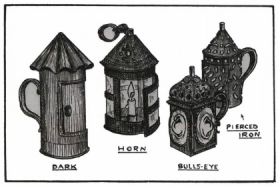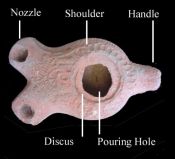Illumination
Illumination describes the amount of visible light that exists in both subterranean and wilderness environments. It is related not only to light sources available to creatures, but also to natural conditions related to weather and astronomical bodies. The effects of illumination, though mundane to most players, require exhaustive explanation, because light is fluid and difficult to quantify with regards to player imagination.
Line of sight and being able to see are of great importance while campaigning, meaning that characters must be resourceful in mastering as many light sources as possible. This is true even for those reliant upon infravision, for this ability still has limitations. Illumination is produced by various means, in the form of devices and through spellcasting.
Contents
Illumination Devices
| Source | Radius in hexes |
Radius in Moonlight |
|---|---|---|
| bluelight (cantrip) | 2 | 2 |
| candle, beeswax | 1 | 2 |
| candle, tallow | 1 | 1 |
| lantern, hooded | 7 | 8 |
| lantern, bullseye | 10 | 10 |
| light (spell) | 4 | 4 |
| oil lamp | 4 | 5 |
| torch, lamp oil | 6 | 12 |
| torch, whale oil | 5 | 10 |
| torch, resting | 2 | 2 |
Below are fashioned light sources.
Candles
An ignitable wick embedded in beeswax or tallow that provides light or, in some cases, a fragrance. Candles produce a small amount of heat and can be used to measure time. Persons who make candles are traditionally called "chandlers." Candles may be held by tabletop candlesticks and candle-holders, or with elaborate candelabra and chandeliers. Candles drip hot substance while they burn, so if they are carried it is best to use some sort of holder.
The illumination provided by a tallow candle is barely enough to light combat hexes adjacent to the carrier, a diameter of about 12 feet. More expensive beeswax does better, providing luminosity enough to light a diameter of 15 feet.
Lanterns
Hooded and bullseye lanterns have a bladder that holds up to 4 fluid ounces of either whale or lamp oil. They feature a glass bubble above this bladder. Once the lantern is lit, a turn-key adjusts a valve that controls the amount of air, which will determine the amount of illumination. All lanterns can be adjusted to illuminate areas from zero to maximum radius for that device. Lanterns will burn oil at a speed proportional to the radius illuminated. Lanterns are commonly made of brass, as more common materials would be too hot to hold comfortably.
It requires 1 AP to adjust the shutter or turn key upon a lantern, and 2 AP to adjust both. It requires 4 AP to light a lantern. Lanterns cannot be lit using a tinder box or a torch; the traditional manner of lighting a lamp is to use a spill.
- Hooded Lanterns are so named because of a metal plate above the glass bubble, which protects the holder's hand from the heat. This also allows the light to be shielded from the holder's eyes if the lantern is held below chest height. This light is cast in all directions. These lanterns stand about 9 in. tall and weigh 1 lb., 11 oz.
- Bullseye Lanterns are fashioned so that the light shines in a horizontal direction, offering a 60° arc of light. These lanterns cannot be made to shine more widely, but a shutter contained within can be adjusted to offer a smaller arc, or closed completely. Even when closed, the bullseye lantern will still show that it is lit, as light will be visible through cracks in the object; but while this will reveal the location of the lantern, it will not provide enough illumination to reveal anything, even the nature of the holder. The lantern's range of illumination is intensified with a lens. These lanterns stand 11 in. tall and 2 lb., 5 oz.
- Bullseye Lanterns are fashioned so that the light shines in a horizontal direction, offering a 60° arc of light. These lanterns cannot be made to shine more widely, but a shutter contained within can be adjusted to offer a smaller arc, or closed completely. Even when closed, the bullseye lantern will still show that it is lit, as light will be visible through cracks in the object; but while this will reveal the location of the lantern, it will not provide enough illumination to reveal anything, even the nature of the holder. The lantern's range of illumination is intensified with a lens. These lanterns stand 11 in. tall and 2 lb., 5 oz.
Oil Lamps
These enlongated bowl-shaped objects include a reservoir for oil in which a wick is inserted through a nozzle and allowed to soak. The wick, once lit, burns steadily. Ceramic is the most common material. The handle usually is held by the index finger, with the thumb pressed to stabilize the lamp. Other handles can be crescent-shaped, triangular or oval-shaped. Lamps may also be slipper-shaped or curved; they may be made of brass or bronze; and they are often superlatively decorated with crosses, animals, human likenesses, birds, fish, trees, plants or flowers. They may be lit using a tinderbox, requiring the same amount of time as lighting a candle.
Spills
A thin object made of straw dipped in tallow, which is lit first from a nearby existing flame and then used to light a pipe or a lantern. Numerous spills are often kept near the fireplace in a spill vase. A spill provides the same amount of illumination as a tallow candle, but it will last for only three rounds before it burns down to the holder's fingers.
Torches
These are the cheapest and most available form of illumination. A torch can be made using a strip of cotton, linen or woolen cloth that is at least 2 inches wide and 36 inches long, which is wrapped repeatedly and then tied around one end of a stake about 18 inch in length. For game purposes, a torch weighs 2 lb., 6 oz. The end is soaked in 1 ounce of whale oil or lamp oil, and sealed with 1 oz. of candlewax. This operation requires 8 action points (AP) to complete, provided all the materials are cut and at hand.
A torch will last for 100 combat rounds. Afterwards, the stake can be reused, though it will lose 1 inch of its length with each use. A 15-inch torch will be hot on the face, whereas a 12-inch torch will feel too unpleasantly hot to hold for more than 25 rounds at a time. A torch less than 10 inches long will be impractical.
A torch dipped in lamp oil will illuminate a radius that is slightly better than one dipped in whale oil. Torches may be put down, though they will sputter on a wet surface after ten rounds and go out; or they may set a dry surface ablaze over the same time (save vs. normal fire). If applied to paper or an airy fibrous substance, the save should be made immediately. A torch that has been laid down will illuminate a smaller radius.
Full moonlight enhances a torch's radius of illumination. It requires two full combat rounds to light a torch. Torches cannot be lit using a tinder box.
Weapons (magical)
Certain magical weapons designed to attack specific creatures, such as reptiles, dragons, shape-shifters, giants and so on, will glow when those creatures are present. Holy weapons will glow in the presence of malevolent creatures. This glow is similar to the cantrip blue light in luminescence. More common magical weapons do not provide this glow.
Other magical items, particularly rods, staves and wands, will bestow a light of their own; this light varies considerably between the possible items, which are too many to list here. Specific details for how much illumination these provide must be judged individually and compared with the measures provided on the illumination page.
Illumination Spells
Bluelight (cantrip)
The bluelight (cantrip) semi-illuminates a diameter of
Range Adjustments
As visible light diminishes, the effective range of missile weapons declines. One method of handling this would be to create a specific table for each weapon. This would be cumbersome and inconvenient. Instead, the Range Adjustment Table provides a proportional conversion for how a given range in combat hexes is affected as the intensity of light diminishes.
| Illumination | Weapon's usual range in hexes | ||||||||||||||||||||||
|---|---|---|---|---|---|---|---|---|---|---|---|---|---|---|---|---|---|---|---|---|---|---|---|
| 2 | 3 | 4 | 5 | 6 | 7 | 8 | 9 | 10-11 | 12-13 | 14-15 | 16-17 | 18-19 | 20-21 | 22-24 | 25-27 | 28-30 | 31-34 | 35-39 | 40-44 | 45-49 | 50-55 | 56+ | |
| Infravision | 2 | 3 | 4 | 5 | 6 | 7 | 8 | 9 | 10 | 12 | 18 | 26 | 34 | 44 | 55 | – | – | – | – | – | – | – | – |
| Dusk | 2 | 3 | 4 | 5 | 6 | 8 | 10 | 11 | 12 | 14 | 17 | 19 | 22 | 24 | 26 | 30 | 34 | 37 | 42 | 48 | 54 | 60 | – |
| Moonlight (full) | 3 | 4 | 6 | 7 | 8 | 10 | 12 | 13 | 14 | 17 | 20 | 22 | 25 | 28 | 31 | 35 | 39 | 43 | 49 | 56 | 63 | – | – |
| Moonlight (dim) | 6 | 9 | 12 | 15 | 18 | 21 | 24 | 27 | 30 | 36 | 42 | 48 | 54 | 60 | 66 | – | – | – | – | – | – | – | – |
| Starlight | 8 | 17 | 22 | 28 | 34 | 39 | 45 | 50 | 56 | – | – | – | – | – | – | – | – | – | – | – | – | – | – |
| Full night | 11 | 30 | 40 | 50 | 60 | – | – | – | – | – | – | – | – | – | – | – | – | – | – | – | – | – | – |
It will be harder to hit objects with hurled or fired missiles outside an illuminated area, particularly since illumination makes the dark seem darker. The table shown indicates penalties accrued when firing at targets beyond the area of illumination, whether or not the shooter is located within that illuminated area (the simplification is used for playability). This penalty is cumulative with normal penalties due to the range of the target.
Additionally, if a combatant or object (including the shooter!) casts a shadow on the target, then the distance "outside illumination" should be measured from the shading object, not the perimeter of illumination.

